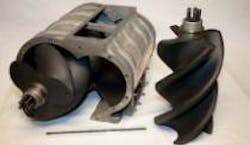Conformable Coating Narrows Compressor Air Gaps, Boosts Efficiency
Authored by: Edited by Jessica Shapiro Key Points Resources |
Automakers are not the only ones trying to make internal-combustion engines that are more efficient and less polluting. Marine applications have also been moving from high-emission two-cycle engines to greener four-cycle models. Whipple Industries, Fresno, Calif., a manufacturer of turbochargers and superchargers for both land and sea vehicles, was looking for a way to boost their products’ efficiency.
Most turbochargers and superchargers are dynamic, screw-type compressors. Their purpose is to push air into ever-smaller spaces. Denser air makes combustion processes more efficient and lets the engine generate more horsepower.
However, compressor efficiency is limited by geometry. Air leaks through the gaps between the rotors, between the housing and rotor tips, and at the output ends of the rotors. And the higher the pressure, the more likely air is to escape back to the low-pressure side of the compressor.
All that leakage is lost efficiency and lost power. In fact, pumping efficiency is related to the clearances between surfaces that push air.
The answer seems easy: The tighter the clearance the better. But that isn’t easily attained.
Because metal surfaces in these screw-type compressors are a three-dimensional spiral slope, machining them to precise dimensions is difficult. Manufacturers usually match each male-female set manually to get the best fit.
The dilemma for designers is that gaps tight enough to seal surfaces risk metal-to-metal contact between the screws. Most rotary and Roots-type superchargers, and many industrial rotary air compressors, don’t use lubricant, so if sealing surfaces touch, they can gall and even seize. On a Roots compressor, lobe-to-lobe clearance is in the range of 0.010 to 0.012 in., and this is considered the smallest possible gap that avoids metal-to-metal contact during operation.
In the past, designers experimented with surface hardening the metal rotors. However, this only delayed galling. It also introduced hard contaminants to the output air. Attempting to close the gap with better precision also inflated machining time and costs.
Compressible coating
One team of designers took another approach. They simply put a special conformable coating on the rotor and got a 5% jump in efficiency. The designers had surmised that placing a material in the gap that would conform to the opposing counterface would narrow the gap and boost efficiency without changing machining tolerances.
One such material, developed by Orion Industries Ltd., Chicago, is DB L-908, an ultrathin, closed-cell, polymer coating. It is mechanically compressible on the nanometer level and has zero compression recovery.
DB L-908, a mixture of polyimide and other resins, contains nanometer-sized wear-resisting particles, as well as solid lubricants such as polytetrafluoroethylene (PTFE). PTFE prevents contacting surfaces from sticking to each other. Small air pockets in the polymer let the coating compress under mechanical pressure.
Once the coating is bonded to the rotor surface, a few turns of the rotor force the coating to conform to individual surfaces on each counterface. And once compressed, the air pockets are crushed so the coating does not rebound, but instead holds the new profile.
As the rotors heat and expand, the coating compensates for thermal expansion by further compressing to match opposing surfaces.
In addition to letting opposing surfaces seal against one another without wear, the coating also eliminates the need for surface finishing. In fact, DB L-908 creates a much closer fit between rotors and housing than precision machining and finishing.
Because the rotating surfaces are composed of compound curves turning at high speeds — usually a multiple of engine speed — the coating must be applied with extreme precision. Robots programmed with CAD data do the job, holding tolerances of ±0.001 in. on all surfaces, including end gaps.
Designers determine the coating thickness for a specific set of rotors in incremental steps. They coat prototype rotors with increasingly thick films. Then they test each film until they find one where the two coated surfaces initially contact one another but the tips still have clearance to pass. Coating thickness ranges from 0.001 to 0.004 in., depending on uncoated rotor clearance and geometry.
The coating cures at approximately 400°F, well below the annealing or distortion temperature of aluminum rotor parts.
Surface in service
Once cured, DB L-908 withstands temperatures of 550°F. It resists corrosion, so it protects metal surfaces from moist and corrosive atmospheres.
Rotors coated with DB L-908 pass 240 hr of ASTM B-117 salt-spray testing. (The standard calls for technicians to place rotors in an enclosed chamber and expose them to 1.0 to 2.0 ml/80 cm2/hr of 5% salt-water spray at over 95°F.)
One manufacturer goes further by running coated compressors in a saline environment for 300 hr at 320°F and follows up with 150,000 cycles between 0 and 13,000 rpm at 300°F on the same unit.
As the rotor temperature rises during service, DB L-908 continues to compress, providing customized and minimal gaps. Also, clearances between rotor tips, and between rotor ends and the housing, are narrowed by slight thermal expansion, which further shrinks the gaps.
Because metal-to-metal contact is eliminated, the compressor generates less noise. And lower friction within the compressor means the output air is cooler and denser.
Whipple Industries chose DB L-908 for to surface the twin screws of its rotary supercharger for marine applications. The supercharger operates at 320°F and 22,000 rpm. For environmental reasons, the supercharger cavity must be oil-free. DB L-908 narrowed the air gap to 0.007 in. or less.
Whipple engineers report 5% greater airflow, which let them reduce the rotors’ rpm. At the same engine speed, this represents a considerable increase in horsepower from the engine due to the denser air. Conversely, slowing engine speed to the original output levels cuts down on “motoring” losses. The net increase in efficiency is approximately 5%.
In addition to coating rotors, DB L-908 is also used on the sides of air and hydraulic motors where it seals the side rotor-to-housing gap.
